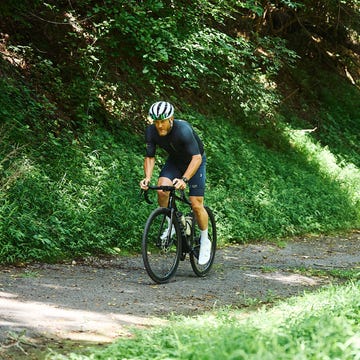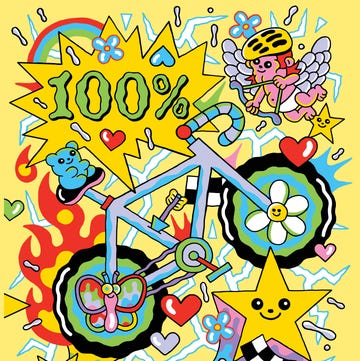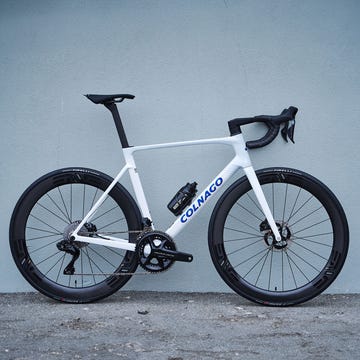Takeaway: SRAM’s overhauled Apex groups are the brand’s lowest-priced parts for road, gravel, and flat bar riding. They offer excellent shifting performance, capable braking, with gearing options well suited to modern gravel and road riding. There is a reasonably priced power meter upgrade option, and extensive cross-compatibility with other SRAM parts as well. Considering the performance and value pricing, are a hit for the intended user and should see wide spec on a variety of drop bar bikes.
SRAM’s lowest priced road and gravel group, Apex, has largely languished since it’s last refresh in 2016. The company’s attention was consumed by its Red, Force, and Rival groups, and it’s game changing mountain bike groups.
But today, drops an all new Apex group. There's an AXS wireless option, and an all new mechanical option too. In either shifting format, Apex is disc brake only with a choice of a wide range (11-44T) or ultra-wide range 1x12 (11-50T or 11-52T) gearing.
Retail availability of Apex AXS parts begins June 15. The parts launch on bikes priced, in SRAM’s estimation, from $2,500 to $4,000. SRAM expects Apex 12-speed mechanical-equipped bikes to arrive at bike shops in September. Prices for those bikes should start under $2,000, according to SRAM.
New Apex AXS and Apex Mechanical Overview
Apex is SRAM’s least expensive road and gravel group. The new Apex parts are 12-speed (formerly, it was an 11-speed group). And for the first time, an Apex AXS (wireless electronic shifting) option accompanies Apex with good old mechanical shifting.
In either electronic or mechanical variant, Apex is a disc brake and one-by (1x) groupset with one of two rear derailleurs: An Eagle rear derailleur for 11-50T or 11-52T cassette, or an XPLR rear derailleur for 11-44T cassette. All derailleurs have clutches for chain retention and less noise in bumpy terrain.
The main differences between Apex at the low end of the range and SRAM’s more expensive groups mostly come down to materials and finishes: Apex is less expensive, heavier (see prices and weights below), and less shiny.
The broad strokes of Apex AXS are the same as SRAM’s other AXS electronic groupsets (Red, Force, Rival). The same motors, batteries, and other electronics are shared across all of SRAM’s drop bar electronic groups, and many of the physical features—chain, cassette, chainring, and crank—are the same also. That means Apex AXS has wide cross-compatibility with SRAM’s other AXS parts—both road and mountain, including the new direct-mount Transmission derailleurs.
Apex AXS can be customized and fine-tuned with SRAM’s AXS app. And like other AXS groups, riders can add wireless Blips (remote shifters—up to six on a single bike), and the Apex controls will actuate a RockShox Reverb AXS dropper post.
Apex mechanical is the first group from SRAM with a mechanical drop bar shifter for 12-speed. I am happy to report the all-new Apex shifter employs the same cable-pull ratio as SRAM’s Eagle mountain bike groups. This means riders can use the Apex shifter with any existing Eagle mechanical rear derailleurs (XX1, X01, GX, NX, SX) or the two Apex mechanical rear derailleurs.
There is a small difference: There is a barrel adjuster on the Apex mechanical rear derailleur body to fine-tune cable tension. In contrast, the mountain bike groups find this adjuster on the shifter, with no adjuster on the derailleur itself. All this means is riders need an in-line tension adjuster if they pair the Apex shifter with one of the mountain bike rear derailleurs.
Digging deeper, there is a noteworthy difference in the Apex-level cassettes. They mount to a standard Shimano HG-style hub driver and, therefore, have an 11-tooth small cog. This 11-tooth is distinct from higher-level SRAM cassettes, which use a 10-tooth cog and mount to SRAM's XDR driver standard.
That one tooth difference on the smallest cog impacts gear range. This is how the gear range breaks down for the different cassettes:
- 10-44T: 440 percent
- 11-44T: 400%
- 10-50T: 500%
- 11-50T: 455%
- 10-52T: 520%
- 11-52T: 473%
The new Apex derailleurs are compatible with SRAM’s 10-tooth cassette. So, if having the widest possible gear range is critical to you (remember, only the smallest cog size differs), you have this option. However, the 10-tooth cassettes require an XDR-compatible rear hub driver body.
One small difference between the XPLR derailleurs for Apex electronic and Apex mechanical. The Apex AXS XPLR derailleur is compatible with SRAM’s 10- or 11-44 XPLR cassette and SRAM’s 10-36 cassette. However, the Apex XPLR mechanical derailleur is only compatible with the 10- or 11-44 cassettes.
The Apex AXS shift/brake levers employ the same lower-profile hood design that debuted with Rival AXS (and has since been adopted by Force AXS), though Apex gets a cosmetically different hood cover. The Apex mechanical hoods are almost identical to the electronic hoods. Another detail to note, both mechanical and electronic shift/brake levers offer adjustable reach.
The brake system is very similar to SRAM’s other drop bar groups. A brand representative stated that Apex offers “The same braking performance as other SRAM brakes.” The pads are the same as used on Rival, Force, and Red series disc brakes, and the hydraulic system runs on DOT fluid like the higher-end brakes. One difference is that Apex brake calipers have a simplified bleed port—they do not use SRAM’s Bleeding Edge system—which might mean a bit of fluid dribble when removing the syringe from the caliper during a flush or bleed.
SRAM offers the Apex cranks with a power meter. This is the same power meter—built into the Dub crank axle and measuring left-side power only—used on Rival and the new Transmission mountain bike groups.
SRAM’s excellent parts cross-compatibility means you will find new Apex on flat bar bikes. Apex drivetrains—mechanical and electronic—work with the company’s existing flat bar shifters. Apex brake calipers are only made in flat mount, but they can be paired with SRAM’s current hydraulic mountain bike brake levers.
Apex is 1x Only
The new Apex groups are 1x-only. But that does not mean using Apex for 2x drivetrains is completely off the table.
For the electronic group, the Apex AXS shift levers work with Rival, Force, or Red AXS front derailleurs. However, the Apex AXS rear derailleurs are 1x specific. If you want to upgrade an Apex AXS group to 2x, you will need a rear derailleur, front derailleur, spider, and chainrings (or one of SRAM’s one-piece double chainring sets) So, while technically possible, it is not cheap to change Apex AXS from 1x to 2x.
It’s a different story with Apex 12-speed mechanical; there is no 2x option available. Apex mechanical is SRAM's only 12-speed drop bar mechanical shift group, and SRAM does not make any 2x option for 12-speed mechanical drivetrains. All of SRAM's 2x12 options are electronic shifting. If you really want 2x with your Apex mechanical, combine it with the Classified Powershift 2-speed internally geared hub.
Prices and Weights
Complete Apex group prices and claimed weights (bottom bracket not included):
Apex AXS
- Apex AXS XPLR: $1,195 / 2,900 grams
- Apex AXS Eagle: $1,292 / 3,191 grams
Apex 12-Speed Mechanical
- Apex 12-Speed Mechanical XPLR: $947 / 2,882 grams
- Apex 12-Speed Mechanical Eagle: $929 / 3,072 grams
A power meter upgrade for all Apex groups is $220 and is about 40 grams heavier than the Apex crank without power meter.
Ride Impressions
So far, I had only one ride on each group—long-term test samples are inbound—on the gravel roads around Galena, Illinois.
On day one, I rode the Apex AXS with XPLR gearing on a lovely Orbea Terra. I’ve ridden all iterations of SRAM’s road and mountain AXS groups. And though Apex is heavier, it shifts and brakes almost identically to those groups.
By that, I mean the shifting is very good. The shift paddles have a nice feel, good feedback, and just the right amount of throw. The chain moves efficiently up and down the cassette. SRAM made great strides in refining the smoothness of their AXS drivetrain shifts and overall drivetrain noise. And those efforts left me with only a few criticisms of SRAM’s AXS shifting.
Could Apex shift faster, smoother, and quieter still? Of course. And I expect those improvements when the next generation of SRAM’s top-of-the-line Red group debuts (which should be soon). But considering that a whole Apex AXS group costs less than a Red power meter crankset—yet Apex’s shifting performance is nearly the same as Red AXS—I have nothing but praise for Apex AXS shifting performance.
On the second day, I rode the Apex mechanical with Eagle gearing on a freaking awesome Salsa Journeyer. Before I get to the rest of the new SRAM bits, I want to shout out this reasonably-priced frame. This bike has some great riding and handling characteristics for its price.
I am impressed with the Apex mechanical shifting. While it uses SRAM’s familiar Double Tap shift action—short push, upshift; long push, downshift—the shift mechanism is all new. Perhaps it is why the Apex shifting felt lighter, smoother, and crisper than any SRAM drop bar mechanical drivetrain I’ve ever ridden, including Red. Additionally, the Apex hood shape is a huge improvement over SRAM’s previous mechanical shift/hydraulic brake offerings, both in appearance and ergonomics.
Now, let us talk about SRAM’s disc brakes. They’re…fine. But fine is about as much enthusiasm as I can generate for them in 2023. Although SRAM’s shifting performance has improved over the years, its road disc brake performance shows little difference from when eTap HRD debuted in 2016.
What was class leading then is meh now. Mostly, it is feel—SRAM’s drop bar brakes feel sluggish and numb at the lever. Power and modulation are adequate, but the overall performance feels slightly unrefined compared to the latest Shimano and Campagnolo road and gravel disc offerings.
Should You Buy Apex?
Niggles about brake lever feel aside, I’m very impressed with SRAM’s new Apex groups. The groups are well suited to current drop bar riding trends, particularly all road and gravel. In either mechanical or wireless electronic, the 1x wide-range drivetrain shifts well, is simple to understand and use, shifts easily, and offers enough range for riding up and down hills comfortably. Other benefits are an inexpensive power meter upgrade (offering riders more data and a way to improve their training performance), extensive compatibility with other SRAM drivetrains, and numerous gearing options.
It appears that SRAM has the right group at the right time. And (it seems) at the right price. I expect to see a ton of Apex parts on bikes in shops very soon.
..
A gear editor for his entire career, Matt’s journey to becoming a leading cycling tech journalist started in 1995, and he’s been at it ever since; likely riding more cycling equipment than anyone on the planet along the way. Previous to his time with Bicycling, Matt worked in bike shops as a service manager, mechanic, and sales person. Based in Durango, Colorado, he enjoys riding and testing any and all kinds of bikes, so you’re just as likely to see him on a road bike dressed in Lycra at a Tuesday night worlds ride as you are to find him dressed in a full face helmet and pads riding a bike park on an enduro bike. He doesn’t race often, but he’s game for anything; having entered road races, criteriums, trials competitions, dual slalom, downhill races, enduros, stage races, short track, time trials, and gran fondos. Next up on his to-do list: a multi day bikepacking trip, and an e-bike race.

























